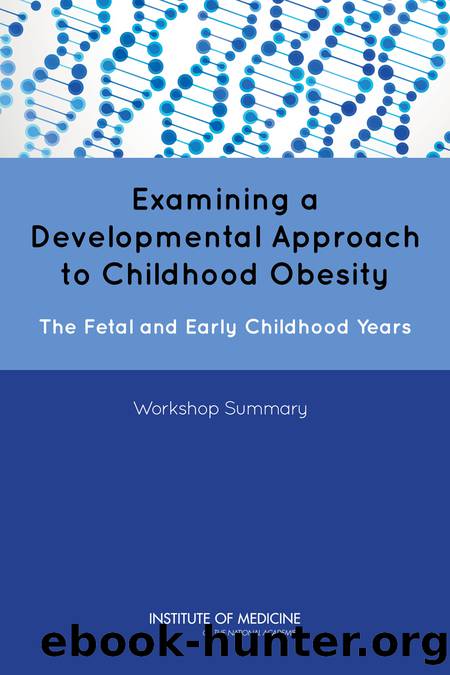Examining a Developmental Approach to Childhood Obesity: The Fetal and Early Childhood Years: Workshop Summary by Leslie A. Pray

Author:Leslie A. Pray
Language: eng
Format: epub
Publisher: The National Academies Press
Published: 2015-10-10T00:00:00+00:00
PANEL DISCUSSIONS WITH SPEAKERS
The Session 3 presentations were accompanied by two separate panel discussions, one following Mark Vickersâs presentation and the other following Antonio Convitâs presentation. Both panel discussions are summarized together here.
Phenotypic Outcomes Associated with Maternal Under-Nutrition Compared to Over-Nutrition
Matthew Gillman asked Karen Lillycrop and Mark Vickers why they thought similar phenotypes emerge at both âendsâ of prenatal nutrition, that is, why the risk of obesity and other metabolic dysfunctions is similar for both under- and over-nutrition during pregnancy. Vickers replied that although many people associate obesity with macrosomia and fetal overgrowth, his models have associated maternal obesity with fetal growth restriction and placental insufficiency in both structure and function. Moreover, most rat models of maternal obesity do not lead to any overgrowth or macrosomia at all. He suspected that the pathways may be similar for both under- and over-nutrition, resulting in similar phenotypic outcomes. With respect to what those outcomes are, he described offspring at both ends of the spectrum tending to be hyperleptinemic and hyperinsulinemic, with reduced birth weight and length.
Lillycrop added that it would be very interesting to compare the undernutrition and over-nutrition pathways in humans and examine epigenetic changes, or signatures, associated with each pathway. If over-nutrition is in fact a consequence of malnutrition in terms of micronutrients, she agreed that the pathways might not be so disparate.
The Mismatch Hypothesis
Gillman asked whether a high-fat diet in utero followed by a high-fat postnatal diet would be âgoodâ based on the mismatch hypothesis, saying, âThatâs a perfect match.â Kevin Grove replied that it depends on the severity. With significant placental insufficiency and a small-for-gestational-age outcome, he suggested that, yes, long-term fat may be âthe answer.â The metabolic outcomes being observed suggest that high-fat-diet offspring may deal better with fat than control-diet offspring. However, the other complications that eventually emerge in association with a high-fat diet, such as inflammation and brain complications, probably end up in the long-term causing more damage.
âWe donât know,â was Vickersâs answer. He observed that many people argue that the mismatch hypothesis works for only one side of the equation, that is, under-nutrition. But, in his opinion, no one has done enough work to see if a high-fat in utero diet matched with a high-fat postnatal diet could result in healthy infants.
Lillycrop added that her research group has bred mice over four generations on a high-fat diet and has observed some adjustment in terms of metabolism. But when the mice start to age, she said, the dysfunction begins to appear.
The Placenta
The speakers were asked whether placental shape or length and width, which could be measured by ultrasound, might be useful as an indicator of risk of obesity. Grove replied that he had spoken many times with David Barker about that possibility. The challenge, Grove said, is that measurements of the size and shapeâor as Barker described it, the âovalityââof the placenta and their association with dysfunction are typically determined postpartum. It is not clear what a dysfunctional placenta looks like in pregnancy. Moreover, placental
Download
This site does not store any files on its server. We only index and link to content provided by other sites. Please contact the content providers to delete copyright contents if any and email us, we'll remove relevant links or contents immediately.
| Administration & Medicine Economics | Allied Health Professions |
| Basic Sciences | Dentistry |
| History | Medical Informatics |
| Medicine | Nursing |
| Pharmacology | Psychology |
| Research | Veterinary Medicine |
Periodization Training for Sports by Tudor Bompa(7946)
Why We Sleep: Unlocking the Power of Sleep and Dreams by Matthew Walker(6385)
Paper Towns by Green John(4826)
The Immortal Life of Henrietta Lacks by Rebecca Skloot(4274)
The Sports Rules Book by Human Kinetics(4097)
Dynamic Alignment Through Imagery by Eric Franklin(3935)
ACSM's Complete Guide to Fitness & Health by ACSM(3834)
Kaplan MCAT Organic Chemistry Review: Created for MCAT 2015 (Kaplan Test Prep) by Kaplan(3815)
Introduction to Kinesiology by Shirl J. Hoffman(3634)
Livewired by David Eagleman(3547)
The River of Consciousness by Oliver Sacks(3431)
The Death of the Heart by Elizabeth Bowen(3355)
Alchemy and Alchemists by C. J. S. Thompson(3312)
Descartes' Error by Antonio Damasio(3170)
Bad Pharma by Ben Goldacre(3117)
The Gene: An Intimate History by Siddhartha Mukherjee(2942)
The Emperor of All Maladies: A Biography of Cancer by Siddhartha Mukherjee(2942)
The Fate of Rome: Climate, Disease, and the End of an Empire (The Princeton History of the Ancient World) by Kyle Harper(2893)
Kaplan MCAT Behavioral Sciences Review: Created for MCAT 2015 (Kaplan Test Prep) by Kaplan(2832)
